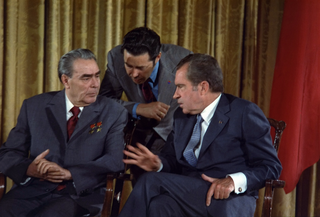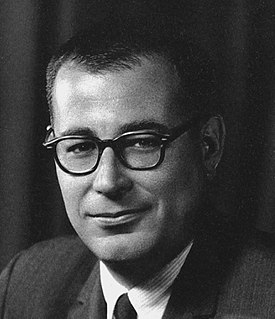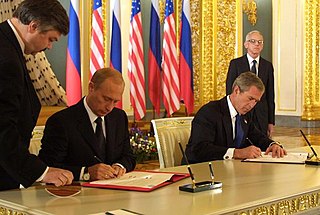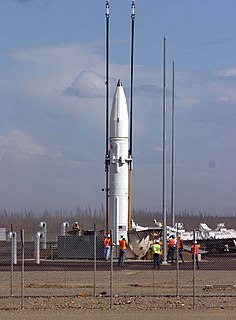Related Research Articles

The Anti-Ballistic Missile Treaty (1972—2002) was an arms control treaty between the United States and the Soviet Union on the limitation of the anti-ballistic missile (ABM) systems used in defending areas against ballistic missile-delivered nuclear weapons. Under the terms of the treaty, each party was limited to two ABM complexes, each of which was to be limited to 100 anti-ballistic missiles.
Arms control is a term for international restrictions upon the development, production, stockpiling, proliferation and usage of small arms, conventional weapons, and weapons of mass destruction. Arms control is typically exercised through the use of diplomacy which seeks to impose such limitations upon consenting participants through international treaties and agreements, although it may also comprise efforts by a nation or group of nations to enforce limitations upon a non-consenting country.

The Strategic Arms Limitation Talks (SALT) were two rounds of bilateral conferences and corresponding international treaties involving the United States and the Soviet Union. The Cold War superpowers dealt with arms control in two rounds of talks and agreements: SALT I and SALT II.

Détente is the relaxation of strained relations, especially political, by verbal communication. The term, in diplomacy, originates from around 1912 when France and Germany tried unsuccessfully to reduce tensions.

START I was a bilateral treaty between the United States and the Soviet Union on the reduction and the limitation of strategic offensive arms. The treaty was signed on 31 July 1991 and entered into force on 5 December 1994. The treaty barred its signatories from deploying more than 6,000 nuclear warheads and a total of 1,600 intercontinental ballistic missiles (ICBMs) and bombers.

The Intermediate-Range Nuclear Forces Treaty was an arms control treaty between the United States and the Soviet Union. US President Ronald Reagan and Soviet General Secretary Mikhail Gorbachev signed the treaty on 8 December 1987. The US Senate approved the treaty on 27 May 1988, and Reagan and Gorbachev ratified it on 1 June 1988.

The nuclear arms race was an arms race competition for supremacy in nuclear warfare between the United States, the Soviet Union, and their respective allies during the Cold War. During this same period, in addition to the American and Soviet nuclear stockpiles, other countries developed nuclear weapons, though none engaged in warhead production on nearly the same scale as the two superpowers.

Harold Brown was an American nuclear physicist who served as United States Secretary of Defense from 1977 to 1981, under President Jimmy Carter. Previously, in the John F. Kennedy and Lyndon B. Johnson administrations, he held the posts of Director of Defense Research and Engineering (1961–1965) and United States Secretary of the Air Force (1965–1969).

START II was a bilateral treaty between the United States and Russia on the Reduction and Limitation of Strategic Offensive Arms. It was signed by US President George H. W. Bush and Russian President Boris Yeltsin on 3 January 1993, banning the use of multiple independently targetable re-entry vehicles (MIRVs) on intercontinental ballistic missiles (ICBMs). Hence, it is often cited as the De-MIRV-ing Agreement. Despite negotiations, it never entered into effect. It was ratified by the US Senate on 26 January 1996 with a vote of 87–4. Although Russia ratified START II on 14 April 2000, it withdrew from the treaty on 14 June 2002 in response to US withdrawal from the ABM Treaty.

The Treaty Between the United States of America and the Russian Federation on Strategic Offensive Reductions (SORT), also known as the Treaty of Moscow, was a strategic arms reduction treaty between the United States and Russia that was in force from June 2003 until February 2011 when it was superseded by the New START treaty.

Missile defense is a system, weapon, or technology involved in the detection, tracking, interception, and destruction of attacking missiles. Conceived as a defense against nuclear-armed intercontinental ballistic missiles (ICBMs), its application has broadened to include shorter-ranged non-nuclear tactical and theater missiles.
The Prevention of Nuclear War Agreement was created to reduce the danger of nuclear war between the United States and the Union of Soviet Socialist Republics. The agreement was signed at the Washington Summit, on June 22, 1973. The United States and the U.S.S.R. agreed to reduce the threat of a nuclear war and establish a policy to restrain hostility.

The militarisation of space involves the placement and development of weaponry and military technology in outer space. The early exploration of space in the mid-20th century had, in part, a military motivation, as the United States and the Soviet Union used it as an opportunity to demonstrate ballistic-missile technology and other technologies having the potential for military application. Outer space has since been used as an operating location for military spacecraft such as imaging and communications satellites, and some ballistic missiles pass through outer space during their flight. As of 2019 known deployments of weapons stationed in space include only the Almaz space-station armament and pistols such as the TP-82 Cosmonaut survival pistol.
START III was a proposed bilateral arms control treaty between the United States and Russia that was meant to reduce the deployed nuclear weapons arsenals of both countries drastically and to continue the weapons reduction efforts that had taken place in the START I and START II negotiations. The framework for negotiations of the treaty began with talks in Helsinki between US President Bill Clinton and Russian President Boris Yeltsin in 1997. However, negotiations broke down, and the treaty was never signed.
National technical means of verification (NTM) are monitoring techniques, such as satellite photography, used to verify adherence to international treaties. The phrase first appeared, but was not detailed, in the Strategic Arms Limitation Treaty (SALT) between the US and USSR. At first, the phrase reflected a concern that the "Soviet Union could be particularly disturbed by public recognition of this capability [satellite photography]...which it has veiled.". In modern usage, the term covers a variety of monitoring technologies, including others used at the time of SALT I.
This article deals with activities of the U.S. Central Intelligence Agency, specifically dealing with arms control, weapons of mass destruction (WMD) and weapons proliferation. It attempts to look at the process of tasking and analyzing, rather than the problem itself, other than whether the CIA's efforts match its legal mandate or assists in treaty compliance. In some cases, the details of a country's programs are introduced because they present a problem in analysis. For example, if Country X's policymakers truly believe in certain history that may not actually be factual, an analyst trying to understand Country X's policymakers needs to be able to understand their approach to an issue.

New START is a nuclear arms reduction treaty between the United States and the Russian Federation with the formal name of Measures for the Further Reduction and Limitation of Strategic Offensive Arms. It was signed on 8 April 2010 in Prague, and, after ratification, entered into force on 5 February 2011. It is expected to last until 5 February 2026, having been extended in 2021.

The Moscow Summit was a summit meeting between U.S. President Ronald Reagan and General Secretary of the Communist Party of the Soviet Union Mikhail Gorbachev. It was held on May 29, 1988 – June 3, 1988. Reagan and Gorbachev finalized the Intermediate-Range Nuclear Forces Treaty (INF) after the U.S. Senate's ratification of the treaty in May 1988. Reagan and Gorbachev continued to discuss bilateral issues like Central America, Southern Africa, the Middle East and the pending withdrawal of Soviet troops from Afghanistan. Reagan and Gorbachev continued their discussions on human rights. The parties signed seven agreements on lesser issues such as student exchanges and fishing rights. A significant result was the updating of Soviet history books, which necessitated cancelling some history classes in Soviet secondary schools. In the end, Reagan expressed satisfaction with the summit.
The Moscow Summit of 1972 was a summit meeting between President Richard M. Nixon of the United States and General Secretary Leonid Brezhnev of the Communist Party of the Soviet Union. It was held May 22–30, 1972. It featured the signing of the Anti-Ballistic Missile (ABM) Treaty, the first Strategic Arms Limitation Treaty, and the U.S.–Soviet Incidents at Sea agreement. The summit is considered one of the hallmarks of the détente at the time between the two Cold War antagonists.

The Vladivostok Summit Meeting on Arms Control was a two-day summit held on November 23 and 24, 1974 in Vladivostok for the purpose of extending arms control provisions between the Soviet Union and the United States. After a series of talks between American President Gerald Ford and Soviet Foreign Minister Andrei Gromyko in Washington and American Secretary of State Henry Kissinger's visit to Moscow, Ford traveled to Vladivostok to meet with Soviet General Secretary Leonid Brezhnev directly. The two heads of state agreed to terms that would limit both nations an "equal aggregate number" of various weapons, including strategic nuclear delivery vehicles (SNDVs), intercontinental ballistic missiles (ICBMs), and submarine-launched ballistic missiles (SLBMs) fitted with multiple independently targetable reentry vehicles (MIRVs).
References
- ↑ US Department of State. "Strategic Arms Limitation Treaty I". SALT I. Retrieved 2007-10-01.